
Wine Culture and Information since 2002 - Volume 22
 Wine Culture and Information since 2002 - Volume 22 |
|
Comparing Recioto di Soave and Verduzzo FriulanoGarganega and Verduzzo Friulano, the two elegant grapes respectively from Veneto and Friuli Venezia Giulia, are also protagonists of excellent sweet wines |
|
Veneto and Friuli Venezia Giulia have a long wine making tradition, well rooted both in time and history, certainly lands mother of great wines. If Veneto is mainly known for its red wines, Friuli Venezia Giulia is known for white wines, however in both regions are being produced excellent sweet wines. In Veneto, the grapes mainly used for the production of sweet wines are both red and white. Among red wines, the main representative is Recioto della Valpolicella, produced with the same grapes of the renowned Amarone, and as for whites, among the protagonists we have Garganega, indisputable queen of Soave and its wines. In Friuli Venezia Giulia two are the grapes used for the production of sweet wines: the famous Picolit and Verduzzo Friulano, the latter also used for the production of Ramandolo, which, together with Colli Orientali del Friuli Picolit, represent the only DOCG wines of the region.
|
|
Recioto di Soave is one of the eight Denominazione d'Origine Controllata e Garantita (DOCG) wines of Veneto. According to the production disciplinary, Recioto di Soave is produced in the styles classico, that is with dried grapes, and spumante (sparkling). The grapes which can be used for the production are 70% Garganega and, for the remaining part, Trebbiano di Soave, Pinot Blanc and Chardonnay, as well as a part of not more than 5% made of non aromatic grapes allowed in the province of Verona. Production disciplinary apart, producers of Recioto di Soave - and the same is true for Soave - generally use Garganega grape only, an autochthonous white berried variety having undeniable quality. Garganega has in fact conquered the main role in the wines of Soave, leaving Trebbiano di Soave to a secondary role, a change which greatly revaluated the whole area and its wines.
The choice of Garganega, instead of Trebbiano di Soave - name with which in the province of Verona is called the Verdicchio grape - was also made because of the different periods of ripening of the two grapes, therefore requiring a longer work in vineyard during harvesting. Recioto di Soave - just like Recioto della Valpolicella - takes its name from the dialectal term recia, that is “ear”, indicating with this term the upper side parts of the bunch, that is the ones mainly exposed to sun rays, therefore richer in sugar. The grape for the production of Recioto, after harvesting, is allowed to dry on mats and in well aerated rooms - in order to avoid the formation of dangerous molds - for a time which can also be of six months. At the end of drying, the grape is crushed and then fermented, a very slow phase - because of the high content in sugar - and which can also last many months. The wine is usually aged in cask - as well as in barrique - for many months, sometimes even years.
|
||||||||
|
Verduzzo Friulano is one of the protagonists of sweet wines in Friuli Venezia Giulia. Versatile grape, used for the production of both table and sparkling wines, as well as sweet wines, Verduzzo Friulano is a white berried variety of which are known two distinct clones. Verduzzo Verde, mainly cultivated in flat lands - mainly in the Grave area - and used for the production of dry and sparkling wines, whereas Verduzzo Giallo, mainly found in hilly areas and in Colli Orientali del Friuli area, is used for the production of demi-sec and sweet wines, of which, the most famous one is Ramandolo. Despite Ramandolo is the wine which mainly represents this sweet style - a DOCG wine, together with Picolit - wines of this type are also produced in the area of Colli Orientali del Friuli. Verduzzo is an autochthonous grape of Friuli Venezia Giulia and it is also one of the oldest grapes known in this territory. Verduzzo Friulano is found in the whole territory of the region and it is used for the production of both dry and sweet wines. Among the areas of the region, Colli Orientali del Friuli is the territory in which this grape is used for the production of sweet wines. Verduzzo Friulano, in the sweet style, is produced by using many wine making techniques. The wines is produced with 100% Verduzzo Friulano and the choice of the containers for the fermentation and aging is pretty wide and according to the choice of each producer. Some in fact prefer to make use of steel tanks, whereas others prefer aging the wine in cask, as well as in the French barrique. The times of aging have quite a broad range: from few months to some years, producing - of course - pretty different results.
|
||||
|
Our comparative tasting will examine two sweet wines produced with Garganega and Verduzzo Friulano, while trying to spot their differences, as well as common characteristics. The first wine of our comparative tasting is Fattori's Recioto di Soave Motto Piane, produced with 100% Garganega and of which, a part fermented and aged in cask for 12 months. The second wine we will examine is Scubla's Colli Orientali del Friuli Verduzzo Friulano Cratis, produced with 100% Verduzzo Friulano, fermented and aged in barrique for 24 months. Both wines are being chosen according to the vintage currently commercialized by respective producers. The two wines will be tasted at the temperature of 14°C (57°F), in order to obtain the right compromise between the perception of aromatic qualities and the excessive perception of sweetness in the mouth. The wines will be poured, as usual, in two ISO tasting glasses.
|
|
The evaluation of appearance in wines produced with dried grapes gives pretty different results. This is because of the color of the wine, usually having different hues according to the period and techniques of the drying of grapes, as well as for the type and variety of grapes. To this should also be considered the type of container used for the fermentation and aging of wine, also considering that in case of wood barrels, the color will get an even deeper and dark hue. The drying of grapes mainly determines the appearance quality of wine, as in this phase, besides having a diminution of water in the berries with the consequent concentration of substances, the juice will get a darker color because of the effects to the exposition to oxygen. In sweet wines produced with white berried grapes, the color has therefore a pretty wide range, sometimes even getting an intense amber yellow color and nuances of the same color. It is rare to see in these wines color lighter than golden yellow. The first wine of which we will examine appearance is Fattori's Recioto di Soave Motto Piane. By holding the glass tilted on a white surface - a sheet of paper is enough - let's observe the color of the wine at the base of the glass in which we will see a brilliant amber yellow color. Let's now observe the wine at the edge of the glass, towards the opening where it has a smaller thickness: here the color gets a brilliant golden yellow hue. Let's now pass to the evaluation of the second wine: Scubla's Colli Orientali del Friuli Verduzzo Friulano Cratis. By observing the glass at the base of the glass, we will see, also in this case, an intense and brilliant amber yellow color, however deeper and darker than the previous wine. Nuances in this wine confirm an evident amber yellow color. Let's now compare the color in the two wines, also according to the different times of aging in wood.
|
|
If it is true the evaluation of aromas is the most interesting phase in sensorial analysis of wines, in sweet wines this aspect becomes amazing. Wines produced with dried grapes - as well as many fortified wines - thanks to the concentration produced by the drying, are enriched by intense and complex aromas. The aging in cask, as well as the fermentation, enriches sweet wines of tertiary aromas which are added to the complexity of wine. Aromas in sweet wines mainly represent a world made of ripe and dried fruits, as well as jams, and complex sensations such as honey and spices. In sweet wines produced with white berried grapes we mainly find aromas recalling white and yellow fruits - such as apple, pear, apricot and peach - as well as dried fruit recalling, for example, almond, dried fig, dried apricot, hazelnut and date. The aging in wood also adds spicy sensations, of which the most common one is vanilla. Let's start the evaluation of aromas from Fattori's Recioto di Soave Motto Piane. By holding the glass in vertical position and without swirling, let's do the first smell in order to appreciate opening aromas, that is the primary qualities characterizing the olfactory profile of a wine. From the glass are perceived intense and clean aromas of raisin, dried apricot and almond, the latter being also common in dry wines produced with Garganega grape. After having swirled the glass, the aromas are completed by the sequence of dried fig, candied fruits, honey, vanilla, date, citrus fruit peel, quince jam and peach jam. Let's now pass to the evaluation of Scubla's Colli Orientali del Friuli Verduzzo Friulano Cratis. The opening of this wine is made of raisin, candied fruits, dried fig and honey, very agreeable and intense. After having swirled the glass, this wine is completed by the aromas of caramel, walnut, orange marmalade, vanilla, apricot jam, date, citrus fruit peel and lavender.
|
|
Wines like the ones of our comparative tasting could be simply defined as sweet, indeed, sweetness is just one of the many qualities needed to reach balance, despite it is the main sensation to be perceived. To the balance of sweet wines produced with white berried grapes are also important acidity, roundness and alcohol. Acidity is among the main factors and avoids the wine to become too much cloying because of the effect of residual sugar. It should also be remembered both alcohol and roundness can increase the sensation of perceived sweetness, therefore the role of acidity is fundamental in order to obtain the right balance. The correspondence to the mouth is generally very good, in which can be easily found the flavors of dried fruits, raisin and honey. In sweet wines, persistence is sometimes amazing, expressing very long times, leaving in the mouth balanced sensations of sweetness and crispness. Let's start the gustatory analysis from Fattori's Recioto di Soave Motto Piane. The attack of this wine - that is the sensations perceived at the first sip - is characterized by an evident sweetness and a pleasing roundness, sensations to which are soon added the burning effect of alcohol and the fresh action of acidity, essential in order to give balance to the wine. Let's concentrate on the correspondence to the nose expressed in the flavors of raisin, dried apricot and almond. Let's now pass to Scubla's Colli Orientali del Friuli Verduzzo Friulano Cratis. Also the attack of this wine is characterized by an evident sweetness and roundness, the latter given not only by the drying of grapes and their concentration, but also by the aging in cask. A characteristic common to both wines - an undeniable sign of quality - is the long persistence perceived in the mouth after the wine has been swallowed: in both cases very long and intense.
|
Wines of the Month |
|
|
|
Score legend Prices are to be considered as indicative. Prices may vary according to the country or the shop where wines are bought |
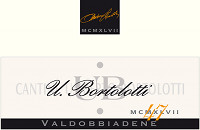
|
|
Valdobbiadene Prosecco Superiore Extra Dry "47" 2009 |
|
| Bortolotti (Veneto, Italy) | |
| Grapes: Glera (90%), Pinot Blanc (10%) | |
| Price: € 11.00 | Score: |
| Valdobbiadene Prosecco Superiore Extra Dry "47" shows a brilliant greenish yellow color and nuances of greenish yellow, very transparent, fine and persistent perlage. The nose reveals intense, clean, pleasing and refined aromas which start with hints of pear, apple and pineapple followed by aromas of peach, wistaria, tangerine and broom. The mouth has good correspondence to the nose, a pleasing sweet and effervescent attack, however balanced by alcohol, light body, intense flavors, pleasing crispness. The finish is persistent with flavors of apple, pear and pineapple. Valdobbiadene Prosecco Superiore Extra Dry "47" ferments in tank and ages in bottle for 5 months. | |
| Food Match: Vegetable and crustacean appetizers, Risotto and pasta with vegetable and crustaceans | |
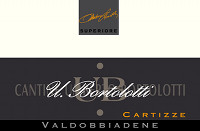
|
|
Valdobbiadene Superiore di Cartizze Dry 2008 |
|
| Bortolotti (Veneto, Italy) | |
| Grapes: Glera | |
| Price: € 18.00 | Score: |
| Valdobbiadene Superiore di Cartizze Dry shows a brilliant greenish yellow color and nuances of greenish yellow, very transparent, fine and persistent perlage. The nose denotes intense, clean, pleasing and refined aromas that start with hints of pear, apple and pineapple followed by aromas of wistaria, tangerine, peach and broom. The mouth has good correspondence to the nose, an effervescent attack and pleasing sweetness, however balanced by alcohol, light body, intense flavors, agreeable. The finish is persistent with flavors of pear, apple and pineapple. Valdobbiadene Superiore di Cartizze Dry ferments in tank and ages in bottle for 5 months. | |
| Food Match: Fruit desserts, Semifreddo | |
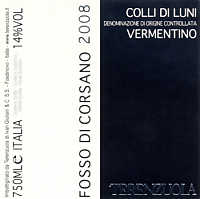
|
|
Colli di Luni Vermentino Fosso di Corsano 2008 |
|
| Terenzuola (Tuscany, Italy) | |
| Grapes: Vermentino | |
| Price: € 13.00 | Score: |
| Colli di Luni Vermentino Fosso di Corsano shows a pale straw yellow color and nuances of greenish yellow, very transparent. The nose denotes intense, clean, pleasing and refined aromas which start with hints of plum, hawthorn and almond followed by aromas of citrus fruits, broom, peach, pear, apple and jasmine. The mouth has good correspondence to the nose, a crisp attack and however balanced by alcohol, good body, intense flavors, pleasing roundness. The finish is persistent with flavors of plum, apple and almond. Colli di Luni Vermentino Fosso di Corsano ages for 6 months in steel tanks followed by at least 3 months of aging in bottle. | |
| Food Match: Roasted white meat, Roasted fish, Stuffed pasta, Mushroom soups | |
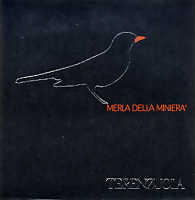
|
|
Merla della Miniera 2006 |
|
| Terenzuola (Tuscany, Italy) | |
| Grapes: Canaiolo Nero (85%), Colorino (15%) | |
| Price: € 8.50 | Score: |
| Merla della Miniera shows an intense ruby red color and nuances of ruby red, little transparency. The nose denotes intense, clean, pleasing and refined aromas which start with hints of black cherry, plum and blueberry followed by aromas of violet, blackberry, vanilla, tobacco, pink pepper, chocolate and menthol. The mouth has good correspondence to the nose, a tannic attack and however balanced by alcohol, good body, intense flavors, pleasing roundness. The finish is persistent with flavors of black cherry, plum and blackberry. Merla della Miniera ages for more than one year in cask followed by 6 months of aging in bottle. | |
| Food Match: Roasted meat, Broiled meat and barbecue, Stewed and braised meat, Hard cheese | |
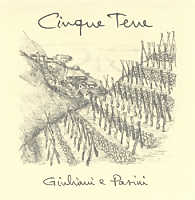
|
|
Cinque Terre 2009 |
|
| Giuliani e Pasini (Liguria, Italy) | |
| Grapes: Bosco, Albarola, Vermentino | |
| Price: € 15.00 | Score: |
| This Cinque Terre shows an intense straw yellow color and nuances of straw yellow, very transparent. The nose reveals intense, clean, pleasing and refined aromas which start with hints of apple, plum and almond followed by aromas of citrus fruits, pear, quince, mineral, hawthorn and fern. The mouth has good correspondence to the nose, a crisp attack and however balanced by alcohol, good body, intense flavors, pleasing roundness. The finish is persistent with flavors of apple, plum and almond. This Cinque Terre ages in steel tanks for 12 months. | |
| Food Match: Fried fish, Sauteed fish, Pasta with fish, Sauteed white meat | |
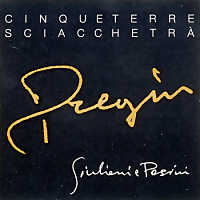
|
|
Cinque Terre Sciacchetrà Pregin 2007 |
|
| Giuliani e Pasini (Liguria, Italy) | |
| Grapes: Bosco, Albarola, Vermentino | |
| Price: € 45.00 - 375ml | Score: |
| Cinque Terre Sciacchetrà Pregin shows a brilliant amber yellow color and nuances of amber yellow, transparent. The nose reveals intense, clean, pleasing and refined aromas that start with hints of dried fig, dried apricot and raisin followed by aromas of quince jam, honey, candied fruits, date, citrus fruit peel, vanilla, walnut and nail polish. The mouth has good correspondence to the nose, a sweet and round attack, however balanced by alcohol, good body, intense flavors, pleasing roundness. The finish is persistent with flavors of dried fig, raisin and candied fruits. Cinque Terre Sciacchetrà Pregin ages for 24 months in steel tanks followed by 6 months of aging in bottle. | |
| Food Match: Almond and jam tarts, Hard cheese, Confectionery | |

|
|
Rugiada 2007 |
|
| Cascina Garitina (Piedmont, Italy) | |
| Grapes: Barbera | |
| Price: € 28.50 - 50cl | Score: |
| Rugiada shows a deep ruby red color and nuances of ruby red, little transparency. The nose denotes intense, clean, pleasing and refined aromas which start with hints of blackberry, black cherry and dried violet followed by aromas of plum, blueberry, vanilla, chocolate, cinnamon, mace, pink pepper and nail polish. The mouth has good correspondence to the nose, a sweet and pleasing tannic attack, however balanced by alcohol, good body, intense flavors, pleasing crispness and roundness. The finish is persistent with flavors of blackberry, black cherry and blueberry. Rugiada is made from dried grapes and ages in cask for 24 months. | |
| Food Match: Hard and piquant cheese, Confectionery | |
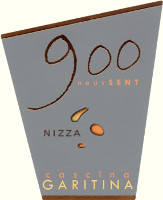
|
|
Barbera d'Asti Superiore Nizza Neuvsent 2007 |
|
| Cascina Garitina (Piedmont, Italy) | |
| Grapes: Barbera | |
| Price: € 17.30 | Score: |
| Barbera d'Asti Superiore Nizza Neuvsent shows an intense ruby red color and nuances of ruby red, little transparency. The nose reveals intense, clean, pleasing, refined and elegant aromas that start with hints of cherry, plum and blackberry followed by aromas of violet, vanilla, blueberry, pink pepper, tobacco, chocolate, clover, mace and menthol. The mouth has good correspondence to the nose, a tannic attack and however balanced by alcohol, full body, intense flavors, pleasing roundness. The finish is persistent with flavors of cherry, plum and blackberry. Barbera d'Asti Superiore Nizza Neuvsent ages for 16 months in cask followed by 6 months of aging in bottle. | |
| Food Match: Game, Roasted meat, Braised and stewed meat, Hard cheese | |
|
|
|
Adarmando 2008 |
|
| Tabarrini (Umbria, Italy) | |
| Grapes: Trebbiano Spoletino | |
| Price: € 13.00 | Score: |
| Adarmando shows a brilliant golden yellow color and nuances of straw yellow, very transparent. The nose denotes intense, clean, pleasing, refined and elegant aromas that start with hints of apple, medlar and melon followed by aromas of hawthorn, pineapple, litchi, broom, hazelnut, peach, plum and pear. The mouth has good correspondence to the nose, a crisp attack and however balanced by alcohol, good body, intense flavors, pleasing roundness. The finish is persistent with flavors of apple, medlar and plum. Adarmando ages for at least 4 months in steel tanks followed by 3 months of aging in bottle. | |
| Food Match: Pasta and risotto with mushrooms and crustaceans, Roasted white meat, Roasted fish | |

|
|
Sagrantino di Montefalco Campo alla Cerqua 2006 |
|
| Tabarrini (Umbria, Italy) | |
| Grapes: Sagrantino | |
| Price: € 30.00 | Score: |
| Sagrantino di Montefalco Campo alla Cerqua shows an intense ruby red color and nuances of ruby red, little transparency. The nose reveals intense, clean, pleasing, refined and elegant aromas which start with hints of blackberry, black cherry and plum followed by aromas of violet, blueberry, pink pepper, vanilla, raspberry, chocolate, cinnamon, mace, tobacco and menthol. The mouth has good correspondence to the nose, a tannic attack and however balanced by alcohol, full body, intense flavors, pleasing roundness. The finish is persistent with flavors of blackberry, black cherry and plum. Sagrantino di Montefalco Campo alla Cerqua ages for 30 months in cask followed by 6 months of aging in bottle. | |
| Food Match: Game, Roasted meat, Stewed and braised meat, Hard cheese | |
|
||||||||
|
DiWineTaste Polls
|
| |||||||
Privacy Policy | |||||||


| Copyright © 2002-2024 Antonello Biancalana, DiWineTaste - All rights reserved |
| All rights reserved under international copyright conventions. No part of this publication and of this WEB site may be
reproduced or utilized in any form or by any means, electronic or mechanical, without permission in writing from DiWineTaste. |